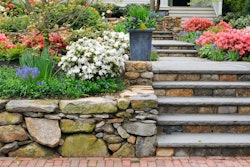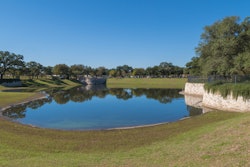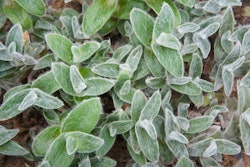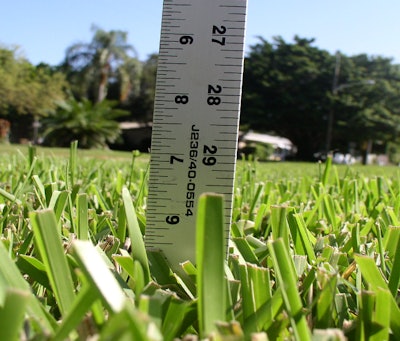
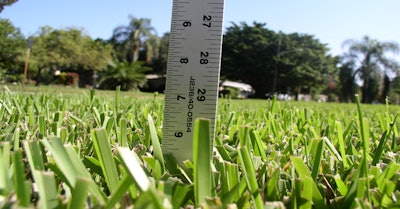 Photo: ILOVETURF.com
Photo: ILOVETURF.comTo a homeowner, the turf that makes up their lawn isn’t given much thought unless it is causing problems. Yet as a lawn care operator, you know there are many nuances to turfgrass and its many species.
Among the warm-season grasses that thrive in temperatures between 75- and 90-degrees Fahrenheit, there is St. Augustine grass. It is a dark green grass with broad, flat blades. It maintains its color longer during a drought compared to Bermuda grass or zoysia grass, which tend to go dormant in droughts.
“St. Augustine is probably the easiest to care for; it’s the darkest green color,” says Rick Orr, agronomist and owner-operator of APL Lawn Spraying based in St. Petersburg, Florida. “It does have a coarse texture, but the coarse texture actually aids in covering up other problems. You take a zoysia lawn, you have one weed in the middle of your lawn and it shows up like a zit on your forehead. Whereas you can have many weeds in a St. Augustine lawn and you’re not going to see them because of the nature of the coarseness of the lawn.”
This particular species is popular along the Gulf Coast and is the most commonly used grass in Florida, according to the University of Florida.
“It’s not very cold tolerant, so you have to be in warmer climates, and it does thrive in sandy soils so those are the places it does well,” Orr says. “It will grow every sort of cultural condition you can think of, except for black shade like the north side of a house where the sun never shines, it will grow.”
It can grow in a wide range of soil types and has a pH range between 5.0 and 8.5.
For those wishing to install St. Augustine grass, it can only be purchased as sod or plugs. St. Augustine grass does not produce enough viable seed for it to be sold commercially, so don’t let your clients be fooled by deceitful sales offers of St. Augustine seeds.
Maintenance needs
As for the type of care St. Augustine grass needs, this warm-season grass likes moisture and should be watered deeply. When the leaf blades wilt, turn a blue-gray color or when footprints remain visible after walking in the grass, the lawn is in need of irrigation.
“Keep it wet,” Orr says. “People get stingy with the water, especially when people are clamoring about a water shortage or drought time, and they’ll cut back on the water. St. Augustine doesn’t need a lot of water, it just needs it consistently. You cannot let it dry out, and people make that mistake. They’ll cut the water off when it’s raining, and then not turn it back on when it stops raining.”
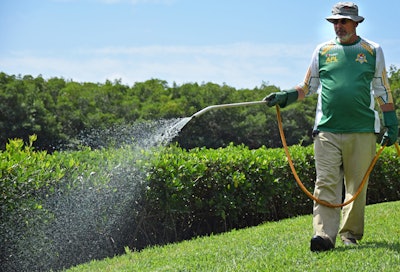 Photo: ILOVETURF.com
Photo: ILOVETURF.comAs for fertilizing, a soil test should be conducted prior to applying any nitrogen. Do not apply too early in the growing season, as the root system will not be fully grown at that time to be able to absorb the nutrients. Likewise, do not fertilize too late in the year after growth has subsided.
According to Lawn Care Academy, established lawns of St. Augustine need only 4 to 5 pounds of nitrogen per 1,000 square feet a year. Over-fertilization can result in diseases and problems with thatch.
Speaking of thatch, St. Augustine grass is one of the species that deals with thatch buildup, which often indicates either overwatering or over-fertilization. If the layer of thatch is over 1 inch, it can be removed by verticutting, or vertical mowing, but this should only be done when the grass is actively growing so it can fix the damage before the next dormant period.
When it comes to mowing, the height that St. Augustine thrives at clashes with what many customers may think of when it comes to a well-groomed lawn. These lawns should be maintained at a height of 3.5 to 4 inches.
“The taller, the better,” Orr says. “I tell my customers all the time to keep it tall and keep it wet. Three inches is the minimum. If you mow it at 4 to 5-inch canopy, the grass is a lot hardier. It recovers from stress a lot faster and it’s greener because there’s more leaf surface.”
Common problems to watch for
In the case of St. Augustine grass, Orr says that while fungal diseases are common, they’re sublethal to the turf, meaning they’re mostly cosmetic problems.
“Brown patch is the one I deal with the most,” Orr says. “It produces these large crop circles in the lawn, but it doesn’t kill, it just generally knocks off the top leaves, and then they’ll be replaced quickly by new leaves and it recovers. But when it’s there, it’s very ugly.”
Dollar spot and gray leaf spot are two other common fungal diseases St. Augustine grass deals with, but Orr says these fungal pathogens are very fragile and changing one cultural condition can cause it to dissipate.
“St. Augustine is susceptible to all the diseases the others have, but zoysia when it gets dollar spot can be quite dramatic, and most people don’t even notice it in St. Augustine,” he says. “Since St. Augustine is a much coarser, taller, darker color grass, it covers up a multitude of problems.”
The greatest threat St. Augustine faces are chinch bugs that are lethal to this type of turfgrass.
“It’s one of the few problems that’s devastating on St. Augustine,” Orr says. “A chinch bug invasion, their damage is so complete there’s no recovery. The lawn is dead. It’s over with.”
The good news is that chinch bugs are easy to control, thanks to their lack of wings and slow movement, preventing them from spreading too far. Chinch bugs favor thatch buildup, so proper cultural controls can keep them at bay.
Common mistakes to avoid
If your clients are wanting a warm-season grass that has outstanding wear tolerance, St. Augustine is not the turfgrass for them. It does not hold up to repeated foot traffic.
“You just can’t play croquet on a St. Augustine lawn,” Orr says. “That’s not what it’s for.”
The number one mistake that Orr says he sees lawn care operators make is what he calls lawn leveling. This is when a lawn care operator looks at the shortest grass in the lawn, sets his mower deck just below that height and mows the whole lawn at that height in an attempt to make it look good.
“What they end up doing mowing it shorter and shorter until eventually it dies and it’s hard to pinpoint when the mow guy did it because it takes months, if not a year, for this low mowing to kill the lawn,” Orr says. “It’s the hardest thing in the world to try and convince people. They think a lawn needs to be a half inch tall to be a lawn. You mow St. Augustine below 3 inches and it will die within a year.”
Another issue is when crews use string trimmers to bevel the edges of the grass near hardscaped surfaces like sidewalks and driveways.
“That’s just a death sentence to the grass because now not only is it exposed to the hot sun, but it also has the reflective heat and absorbed heat from the concrete edges and so we call them distressed edges,” Orr says. “A lot of that could be solved by weed eating at the same height as the mower, matching the mower height.”
Orr also advises caution for landscapers considering using some of the newer cultivars of St. Augustine, as they have a new subset of problems compared to tried and true varieties like ‘Floratam,’ which has issues as well, but these are ones that are easily solved.

